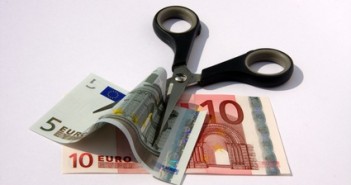Consensus of economists points to no change in the ECB’s rates. However, there is room for surprise. Worrying signs about Germany and France were already seen beforehand. They now seem more serious and not a onetime event, especially as Draghi clearly expressed worries about Germany, and reversed the rally of EUR/USD.
The situation in Germany, together with the growing notion that Greece will need another debt restructuring, Spain’s rising yields (reluctant to take a bailout), and also fear of credit crunch in the old continent could push Draghi to action, or at least to bigger hints about cutting the rates. Will the EUR/USD slide be further extended? Analysis.
* This article is part of the November monthly forex report. You can download the full report by joining the newsletter in the form below.
During November, Europe will release the GDP numbers, which will likely place the whole euro-zone in an official recession.
German and French recession coming
Of important note is Germany – the largest economy and the core of the core. Purchasing managers’ indices did not improve, and no change is expected now. In addition, the traditionally optimistic IFO Business Climate figure continued to disappoint and fell to exactly 100 points. Another drop means a psychological loss of one digit and inflict more damage.
The most worrying indicator comes from the labor market, where unemployment began moving in the wrong direction. With an unemployment rate of only 6.9%, many other European countries can envy Germany. However, the consistent rise in the number of unemployed people, last time by a whopping 20K, shows that Germany is not immune.
In France, PMIs have improved, but the second largest economy does suffer from other issues: President François Hollande has ended his grace period and the new taxes on the rich and on entrepreneurs have failed to raise praises. While France isn’t officially in recession, its economy is not growing – 0% during two quarters.
It is likely that both core countries saw their economies contract in Q3, and Q4 doesn’t look better.
Another Rate Cut?
The ECB has been focusing on the debt crisis of late, announcing and then detailing about the OMT program, which is awaiting a Spanish bailout request. However, it is important to remember that the central bank’s official single mandate (“needle in the compass”) is price stability – setting interest rates to maintain inflation
In that context, Draghi has recently made an interesting statement about the downside risks of prices – deflation. When prices are falling, consumers anticipate lower prices and refrain from buying. This pushes prices even lower and in turn makes consumers even more reluctant to spend. Such a deflation spiral is also bad for debt – it is harder to lower debt levels when GDP is falling.
The remark comes despite official inflation actually sitting above the ECB’s 2% target. However, the central bank sees inflation falling in 2013, and with more signs of a deeper recession, it might be pro—active.
Draghi already showed in various occasions that he is not conservative as his predecessor Jean-Claude Trichet. This was seen in the LTRO, OMT, and also in a rate cut earlier in the year – a move that sent the lending rate to 0.75% and the deposit rate to 0%. The cut of the lending rate below 1% was not seen earlier. Throughout the crisis, Trichet kept the rate at 1% and even raised it twice in 2011. 1% was a floor, and Draghi already broke it.
So, in the November 8th meeting, there is a good chance that Draghi will take one step further and cut the rate from 0.75% to 0.50%, leaving the deposit rate unchanged.
Such a move could hit the euro. It is important to remember that the cut to 0.75% was widely expected, but it still hurt the euro – it –as not a “buy the rumor, sell the fact” event.
No No LTRO – Yes Yes SMP?
More support for a rate cut comes from the fear that a credit crunch is coming. Banks are lending less money and this limits the prospects of any recovery. A similar situation happened towards the end of 2011, and Draghi then announced the LTRO – lending cheap money to banks, in order to ignite economic activity and to lower sovereign bond yields.
Using two rounds of 3 year loans that reached 1 trillion euros, banks lent cheap money from the ECB, bought sovereign bonds of their respective countries (often with leverage) and pledged them as collateral with the ECB.
When fears about stability rose once again, the banks saw leveraged losses on their buys of bonds, and they are in debt to the ECB. In addition, governments became even more dependent on their banks – exactly the opposite of the bold declarations made in the June EU Summit.
All in all, the LTRO backfired and would probably not be used again as a tool of monetary easing. Cutting the interest rates therefore seems like the preferred option.
There is one more option left: using the legacy SMP program – the ECB already bought sovereign debt directly, beginning in May 2010. Around 200 billion euros of peripheral debt was accumulated without “conditionality” as Draghi said about the new OMT program, which requires a bailout. It is easy to read the criticism that Draghi had about his predecessor Trichet.
Yet while the SMP is currently dormant, it could still be reawakened. It would be a total U-turn for Draghi and his credibility, but it could ease market pressure at a time that economies are contracting, money is in danger of contracting and the while the OMT is still waiting.
As aforementioned, Draghi has shown ability to make bold moves. This would be a move he wouldn’t like to do, but if Greece leaves the euro-zone, the SMP is one of the tools in the shed.
